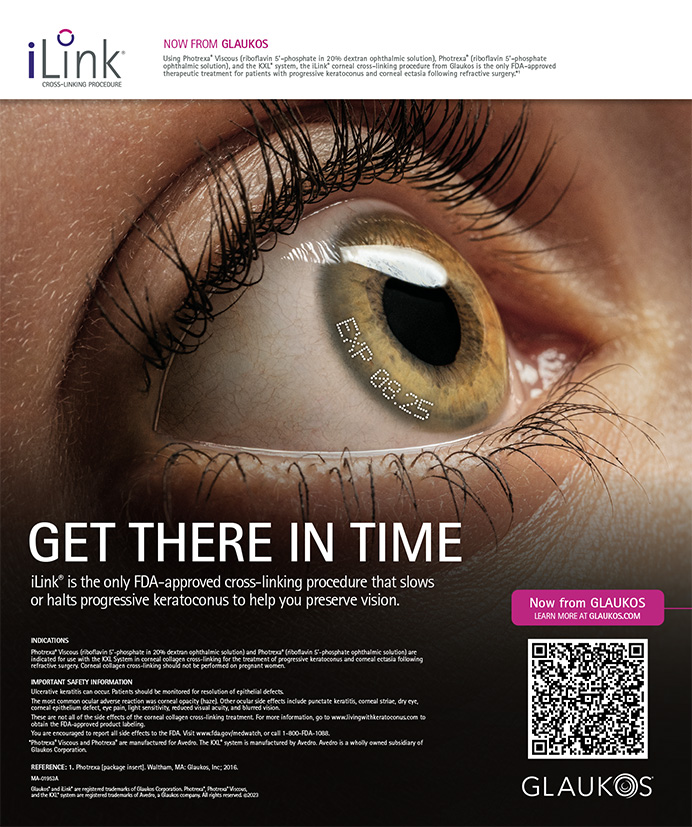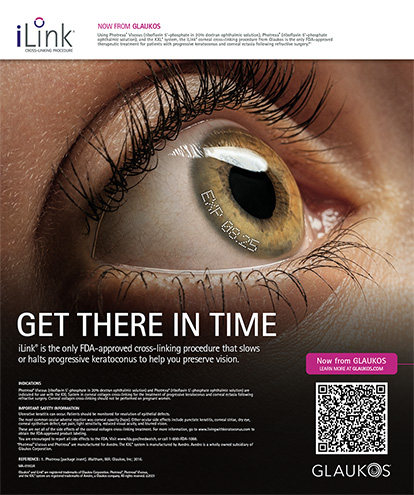Across the globe, laser vision correction superseded incisional keratotomy as the dominant form of corneal refractive surgery in the first half of the 1990s. Since then, more than 34 million eyes have undergone excimer laser vision correction (PRK, LASIK, LASEK) worldwide.1 During my almost 20 years of performing LASIK, internal surveys at my practice have found that 99% of patients are happy with their result, would have the procedure again, and would recommend it to friends and family. More objectively, a March 2008 meta-analysis by the American Society of Cataract and Refractive Surgery of 2,915 peer-reviewed articles published during a 10-year period found a 95.4% rate of satisfaction among LASIK patients worldwide.2
Never complacent, refractive surgeons seek better procedures with a lower incidence of complications, fewer side effects, and lower retreatment rates. Such an advance may be imminent with the all-femtosecond-laser corneal refractive surgery developed by Carl Zeiss Meditec and dubbed SMILE (small-incision lenticule extraction; not approved in the United States).
THE PROCEDURE
SMILE differs from LASIK in that an excimer laser is not used to sculpt tissue and no photoablation is performed. Instead, the surgeon creates a lenticule of tissue with a femtosecond laser and manually removes the tissue through a short, arc-length incision. The lenticule is equivalent to the predicted shape of the Munnerlynn formula ablation profile of the excimer laser.
The VisuMax laser (Carl Zeiss Meditec) creates a three-dimensional refractive lenticule for myopic spherical and compound myopic spherical treatments ranging from 1.00 to more than 10.00 D of myopia and up to 5.00 D of astigmatism. The small-incision part of procedure’s name refers to the replacement of a 270º flap with a 30º to 60º incision through which the surgeon accesses the intrastromal pocket and removes the lenticule. The outer diameter of a typical lenticule is 6.5 mm. The cap of the entire pocket is 120 μm throughout. The posterior surface of the lenticule is convex and determined by the dioptric power treated. The greater the myopia, the thicker the lenticule or more convex its posterior surface for myopic treatments. The outer dimension of the pocket is 7.5 mm, so the distance from the edge of the lenticule to the periphery of the pocket is exactly 0.5 mm for 360º, which provides room for the lenticule’s removal.
BENEFITS
The first and most obvious benefit of SMILE versus LASIK is the avoidance of flap-related complications such as slippage. No flap is created, Bowman layer is minimally violated, and less anterior stroma is incised. For these reasons, SMILE theoretically preserves the most biomechanically significant anterior one-third of the cornea, thus maximizing corneal tensile strength. Greater preservation of the anterior cornea with lesser interruption of the corneal nerves may also mean fewer complaints of dry eye from neurotrophia after SMILE versus LASIK.
A unique feature of SMILE is that it is basically completed in a vacuum (ie, intrastromally). In contrast, the excimer laser beam must traverse the final lens in the optical train and pass through air to the corneal surface. During LASIK, therefore, the room’s environment (eg, air purity, humidity, barometric pressure, and temperature) affects the laser’s photoablative ability and the amount of dry cornea removed with each pulse of energy. The environment’s effect will vary from day to day, case to case, and surgeon to surgeon.3 During a SMILE procedure, the closed environment of an intact cornea coupled to the femtosecond laser with a patient interface avoids this variability. This explains why a -10.00 D treatment is just as predictable as a -1.00 D diopter SMILE treatment (FDA data on file with Zeiss). In my experience, a -1.00 D SMILE procedure is as predictable as a -1.00 D excimer laser correction.
MARKETPLACE
Can SMILE compete with LASIK? In 1996, I wrote an article, “The Tenets of Refractive Surgery.”4 In it, I discussed the characteristics of the “ideal” refractive surgery procedure. The key points were (and remain) predictability, effectiveness, stability of the result, safety, and quality of vision. Lesser attributes included reversibility/adjustability, minimal wound healing, immediacy of the final refractive outcome, an ability to meet patients’ and providers’ expectations, and equivalence or superiority to glasses or contact lenses. LASIK meets these criteria better than any procedure that predates it. Can SMILE compete? Procedural counts may provide an indication. In 2009, 200 SMILE procedures were performed worldwide. The number climbed to 20,000 by December 2012, to 50,000 by the end of July 2013, and to 80,000 by December 2013.
STATUS
The US FDA clinical trial of SMILE is underway at five sites. The spherical myopia study will involve treatment of 340 eyes. Enrollment is expected to be complete in June 2014. Approval of the procedure could occur between 2016 and 2018. Laser vision correction, particularly LASIK, remains the king of the refractive jungle, but in the nottoo- distant future, it could be challenged by SMILE. The outcome? As the late Charles Kelman, MD, said, “While doctors debate, patients decide.”
John F. Doane, MD, is in private practice with Discover Vision Centers in Kansas City, Missouri, and he is a clinical assistant professor with the Department of Ophthalmology, Kansas University Medical Center in Kansas City, Kansas. He has been paid for research overhead in Carl Zeiss Meditec’s FDA clinical trial of the SMILE procedure. Dr. Doane may be reached at (816) 478-1230; jdoane@discovervision.com.
- Stuart A. A look at LASIK past, present and future. EyeNet Magazine. Published June 2009. http://www.aao.org/ publications/eyenet/200906/feature.cfm. Accessed June 5, 2014.
- Solomon KD, Fernández de Castro LE, Sandoval HP, et al; Joint LASIK Study Task Force. LASIK world literature review: quality of life and patient satisfaction. Ophthalmology. 2009;116(4):691-701.
- Dougherty PJ, Wellish KL, Maloney RK. Excimer laser ablation rate and corneal hydration. Am J Ophthalmol. 1994;118(2):169-176.
- Doane J, Nordan L, Baker R, Slade S. The tenets of lamellar refractive surgery. Ocular Surgery News. 1996;14(13):31.


